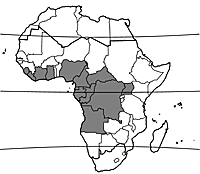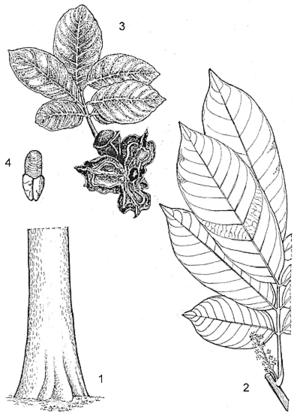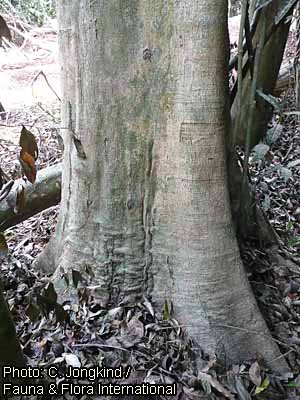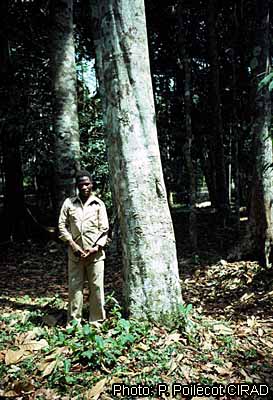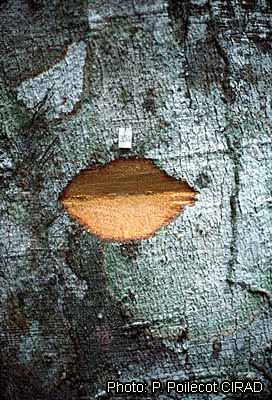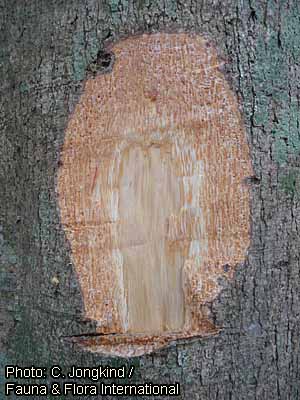Blighia welwitschii (PROTA)
Introduction |
| General importance | |
| Geographic coverage Africa | |
| Geographic coverage World | |
| Fruit | |
| Spice / condiment | |
| Medicinal | |
| Timber | |
| Fuel | |
Blighia welwitschii (Hiern) Radlk.
- Protologue: Engl., Pflanzenr. IV 165: 1146 (1933).
- Family: Sapindaceae
- Chromosome number: 2n = 32
Origin and geographic distribution
Blighia welwitschii occurs from Sierra Leone eastward to Uganda and south to DR Congo and northern Angola. It is only occasionally planted, for instance in botanical gardens.
Uses
The wood, traded as ‘tsana’, is commonly used for light construction, light flooring, joinery, interior trim, furniture, poles, piles, mine props, toys, novelties, boxes, crates, pestles, mortars, agricultural implements, oars and turnery. It is suitable for ship building, railway sleepers, veneer, plywood and pulpwood.
In DR Congo the bark is used as a revulsive on the skin to relieve kidney, costal and lumbago pain. A bark decoction is taken as a purgative and to treat cough. Powdered leaves are eaten with ripe banana as an aphrodisiac. In Côte d’Ivoire and Nigeria, leaf decoctions are taken as cholagogue. In Congo leaf sap is applied to treat ear inflammations. In Sierra Leone the bark, young leaves, fruits and seeds are used as fish poison.
In Liberia the fragrant young leaves are used for flavouring soup. Mature seed arils are eaten, but the arils of unripe seeds may be toxic, as well as the seeds.
Production and international trade
The wood is locally used and rarely traded on the international market.
Properties
The heartwood is pale brown to reddish brown, often with white specks, and usually distinctly demarcated from the white to pinkish yellow, about 10 cm wide sapwood. The grain is straight or interlocked, texture usually moderately fine. Quarter-sawn material usually shows a ribbon stripe of narrow vertical bands alternately yellow and brown. The wood is moderately lustrous.
The wood is moderately heavy to heavy with a density of 730–950 kg/m³ at 12% moisture content, and very strong, tough and quite hard. The rates of shrinkage are high, from green to oven dry 6.5–7.0% radial and 10.3–11.5% tangential. It is recommended to quarter-saw logs immediately after felling to prevent checking during drying. Once dry, the wood is rather unstable in service.
At 12% moisture content, the modulus of rupture is 112–205 N/mm², modulus of elasticity 15,000 N/mm², compression parallel to grain 69–84 N/mm², cleavage 25–36 N/mm and Chalais-Meudon side hardness 6.4–7.4.
The wood saws well but slowly, and works easily with both machine and hand tools despite its high density. It polishes and sands to an attractive finish. It has good nailing and screwing properties and hold nails firmly, and glues moderately well. The wood is moderately durable and quite resistant to insect attacks, but it is susceptible to Lyctus attack. It is difficult to treat with preservatives.
Several saponins have been isolated from the fruits, some of which showed insecticidal activity against Spodoptera frugiperda and toxicity in the brine shrimp test.
Description
- Evergreen, dioecious, medium-sized to fairly large tree up to 40(–50) m tall; bole branchless for up to 30 m, cylindrical, usually straight, up to 100(–180) cm in diameter, slightly fluted at base or sometimes with small, thick buttresses; bark surface smooth to slightly fissured or flaky, grey to brown, inner bark hard, granular, yellow to orange, often yellow-brown mottled; crown often dense, with ascending branches, dark green; young twigs orange-hairy, soon becoming glabrous and dark brown.
- Leaves alternate, paripinnately compound with 2–4 pairs of leaflets; stipules absent; petiole up to 8(–16) cm long, narrowly winged, rachis up to 15 cm long; petiolules up to 1 cm long; leaflets opposite, narrowly elliptical to oblong-elliptical, up to 25(–40) cm × 8.5(–10) cm but often much smaller in lowest pair, cuneate to obtuse and sometimes asymmetrical at base, short-acuminate at apex, margins entire or slightly wavy, leathery, nearly glabrous, pale brown when young, later becoming olive green, pinnately veined with 7–14(–20) pairs of lateral veins.
- Inflorescence an axillary false raceme up to 12(–15) cm long.
- Flowers unisexual, regular, 5-merous, white or greenish white, sweet-scented; pedicel up to 8 mm long, elongating up to 10 mm in fruit; calyx with tube much shorter than lobes, c. 2 mm long; petals free, rhomboid, up to 5 mm × 3 mm, hairy, with a large scale on the inner face; stamens 7–8, free, filaments c. 5 mm long, hairy; ovary superior, hairy, usually 3-lobed and 3-celled, style about as long as ovary; male flowers with rudimentary ovary, female flowers with reduced stamens.
- Fruit a top-shaped or pear-shaped, usually 3-gonous capsule 3.5–8 cm × 2.5–4.5 cm, pointed at apex, orange to red when ripe, glabrous, dehiscing with 3 woody recurving valves hairy inside, up to 3-seeded.
- Seeds ovoid to ellipsoid, 2–3 cm long, glossy dark brown to purplish black, with yellow cup-shaped aril up to 2 cm long at base.
- Seedling with hypogeal germination; epicotyl 10–15 cm long, hairy; first 2 leaves opposite, with 3 obovate leaflets up to 12 cm × 4 cm.
Other botanical information
Blighia comprises 3 species and is restricted to tropical Africa. Blighia welwitschii can be distinguished from the other two species by its fairly large fruits with sharp-edged lobes. Var. bancoensis Aubrév. & Pellegr. has been described from Côte d’Ivoire and is characterized by comparatively small fruits (3.5–4 cm long).
Anatomy
Wood-anatomical description (IAWA hardwood codes):
- Growth rings: 1: growth ring boundaries distinct; 2: growth ring boundaries indistinct or absent.
- Vessels: 5: wood diffuse-porous; (7: vessels in diagonal and/or radial pattern); 13: simple perforation plates; 22: intervessel pits alternate; 23: shape of alternate pits polygonal; (24: intervessel pits minute (≤ 4 μm)); 25: intervessel pits small (4–7 μm); 30: vessel-ray pits with distinct borders; similar to intervessel pits in size and shape throughout the ray cell; 42: mean tangential diameter of vessel lumina 100–200 μm; 46: ≥ 12 rays per mm.
- Mineral inclusions: 136: prismatic crystals present; (137: prismatic crystals in upright and/or square ray cells); 138: prismatic crystals in procumbent ray cells.
Growth and development
In Côte d’Ivoire Blighia welwitschii trees have been recorded to flower between August and May, but most commonly in November. They develop ripe fruits about 6 months after flowering; in Côte d’Ivoire and Gabon fruits mature most commonly in December to February. The seeds with their yellow aril are probably dispersed by animals such as large birds and monkeys. In Gabon they are a favorite food of the African grey parrot.
Ecology
Blighia welwitschii occurs mostly in moist evergreen forest, in primary as well as secondary forest, but it can also be found in semi-deciduous forest. In Uganda it is found up to 1150 m altitude.
Management
In general Blighia welwitschii occurs at low density in the forest. Locally in Cameroon, an average density of 2.7 trees of more than 15 cm in bole diameter per ha has been recorded, with an average wood volume of 2.1 m³/ha.
Diseases and pests
In Côte d’Ivoire Blighia welwitschii has been reported to be a host of okra mosaic virus. Blighia welwitschii showed symptoms that were similar to that of the infected vegetables, i.e. leaves with chlorosis near the veins, and was considered to pose a risk when planted close to okra fields.
Genetic resources
Blighia welwitschii is widespread and not extensively logged. Therefore, it does not seem to be liable to genetic erosion at present.
Prospects
Blighia welwitschii is a useful local source of wood and traditional medicine. Research is warranted on growth rates, regeneration and propagation, as well as management requirements for sustainable production, before any judgement can be made about its potential role in commercial timber production. Investigations on the possible toxicity of young leaves and seed arils are needed to guarantee safe consumption by humans.
Major references
- Aubréville, A., 1959. La flore forestière de la Côte d’Ivoire. Deuxième édition révisée. Tome deuxième. Publication No 15. Centre Technique Forestier Tropical, Nogent-sur-Marne, France. 341 pp.
- Burkill, H.M., 2000. The useful plants of West Tropical Africa. 2nd Edition. Volume 5, Families S–Z, Addenda. Royal Botanic Gardens, Kew, Richmond, United Kingdom. 686 pp.
- Davies, F.G. & Verdcourt, B., 1998. Sapindaceae. In: Beentje, H.J. (Editor). Flora of Tropical East Africa. A.A. Balkema, Rotterdam, Netherlands. 108 pp.
- de Koning, J., 1983. La forêt de Banco. Part 2: La Flore. Mededelingen Landbouwhogeschool Wageningen 83–1. Wageningen, Netherlands. 921 pp.
- Hauman, L., 1960. Sapindaceae. In: Robyns, W., Staner, P., Demaret, F., Germain, R., Gilbert, G., Hauman, L., Homès, M., Jurion, F., Lebrun, J., Vanden Abeele, M. & Boutique, R. (Editors). Flore du Congo belge et du Ruanda-Urundi. Spermatophytes. Volume 9. Institut National pour l’Étude Agronomique du Congo belge, Brussels, Belgium. pp. 279–384.
- Savill, P.S. & Fox, J.E.D., 1967. Trees of Sierra Leone. Forest Department, Freetown, Sierra Leone. 316 pp.
- Widodo, S.H., 2001. Crescentia L. In: van Valkenburg, J.L.C.H. & Bunyapraphatsara, N. (Editors). Plant Resources of South-East Asia No 12(2): Medicinal and poisonous plants 2. Backhuys Publishers, Leiden, Netherlands. pp. 191–194.
- Vivien, J. & Faure, J.J., 1985. Arbres des forêts denses d’Afrique Centrale. Agence de Coopération Culturelle et Technique, Paris, France. 565 pp.
- Wilks, C. & Issembé, Y., 2000. Les arbres de la Guinée Equatoriale: Guide pratique d’identification: région continentale. Projet CUREF, Bata, Guinée Equatoriale. 546 pp.
Other references
- Fouarge, J. & Gérard, G., 1964. Bois du Mayumbe. Institut National pour l’Etude Agronomique du Congo (INEAC), Brussels, Belgium. 579 pp.
- Fouilloy, R. & Hallé, N., 1973. Sapindacées. Flore du Cameroun. Volume 16. Muséum National d’Histoire Naturelle, Paris, France. 202 pp.
- Fouilloy, R. & Hallé, N., 1973. Sapindacées. Flore du Gabon. Volume 23. Muséum National d’Histoire Naturelle, Paris, France. 202 pp.
- Givord, L., 1978. Alternative hosts of okra mosaic virus near plantings of okra in southern Ivory Coast. Plant Disease Reporter 62(5): 412–416.
- Hawthorne, W.D., 1995. Ecological profiles of Ghanaian forest trees. Tropical Forestry Papers 29. Oxford Forestry Institute, Department of Plant Sciences, University of Oxford, United Kingdom. 345 pp.
- Hawthorne, W. & Jongkind, C., 2006. Woody plants of western African forests: a guide to the forest trees, shrubs and lianes from Senegal to Ghana. Kew Publishing, Royal Botanic Gardens, Kew, United Kingdom. 1023 pp.
- Hubrecht, F., Delaude, C., Gilson, J.C. & Gaspar, C., 1989. Activité de plusieurs saponines extraités de plantes originaires du Zaire à l’égard de Spodoptera frugiperda J.E. Smith. Mededelingen van de Faculteit Landbouwwetenschappen, Rijksuniversiteit Gent 54(3a): 937–944.
- Irvine, F.R., 1961. Woody plants of Ghana, with special reference to their uses. Oxford University Press, London, United Kingdom. 868 pp.
- Keay, R.W.J., 1958. Sapindaceae. In: Keay, R.W.J. (Editor). Flora of West Tropical Africa. Volume 1, part 2. 2nd Edition. Crown Agents for Oversea Governments and Administrations, London, United Kingdom. pp. 709–725.
- Keay, R.W.J., Onochie, C.F.A. & Stanfield, D.P., 1964. Nigerian trees. Federal Department of Forest Research, Ibadan, Nigeria. 495 pp.
- Neuwinger, H.D., 2000. African traditional medicine: a dictionary of plant use and applications. Medpharm Scientific, Stuttgart, Germany. 589 pp.
- Oteng-Amoako, A.A. (Editor), 2006. 100 tropical African timber trees from Ghana: tree description and wood identification with notes on distribution, ecology, silviculture, ethnobotany and wood uses. 304 pp.
- Penders, A. & Delaude, C., 1994. Structure elucidation of an acetylated saponin of Blighia welwitschii by NMR spectroscopy. Carbohydrate Research 263(1): 79–88.
- Penders, A., Delaude, C., Pepermans, H. & Van Binst, G., 1989. Identification and sequencing of sugars in an acetylated saponin of Blighia welwitschii by NMR spectroscopy. Carbohydrate Research 190(1): 109–120.
- Sallenave, P., 1955. Propriétés physiques et mécaniques des bois tropicaux de l’Union française. Centre Technique Forestier Tropical, Nogent sur Marne, France. 129 pp.
- White, L. & Abernethy, K., 1997. A guide to the vegetation of the Lopé Reserve, Gabon. 2nd edition. Wildlife Conservation Society, New York, United States. 224 pp.
Sources of illustration
- Aubréville, A., 1959. La flore forestière de la Côte d’Ivoire. Deuxième édition révisée. Tome deuxième. Publication No 15. Centre Technique Forestier Tropical, Nogent-sur-Marne, France. 341 pp.
- Vivien, J. & Faure, J.J., 1985. Arbres des forêts denses d’Afrique Centrale. Agence de Coopération Culturelle et Technique, Paris, France. 565 pp.
- White, L. & Abernethy, K., 1997. A guide to the vegetation of the Lopé Reserve, Gabon. 2nd edition. Wildlife Conservation Society, New York, United States. 224 pp.
- Wilks, C. & Issembé, Y., 2000. Les arbres de la Guinée Equatoriale: Guide pratique d’identification: région continentale. Projet CUREF, Bata, Guinée Equatoriale. 546 pp.
Author(s)
- E.A. Obeng, Forestry Research Institute of Ghana (FORIG), University P.O. Box 63, KNUST, Kumasi, Ghana
Correct citation of this article
Obeng, E.A., 2010. Blighia welwitschii (Hiern) Radlk. [Internet] Record from PROTA4U. Lemmens, R.H.M.J., Louppe, D. & Oteng-Amoako, A.A. (Editors). PROTA (Plant Resources of Tropical Africa / Ressources végétales de l’Afrique tropicale), Wageningen, Netherlands. <http://www.prota4u.org/search.asp>.
Accessed 23 December 2024.
- See the Prota4U database.

